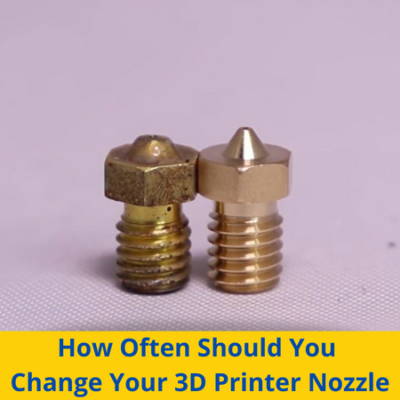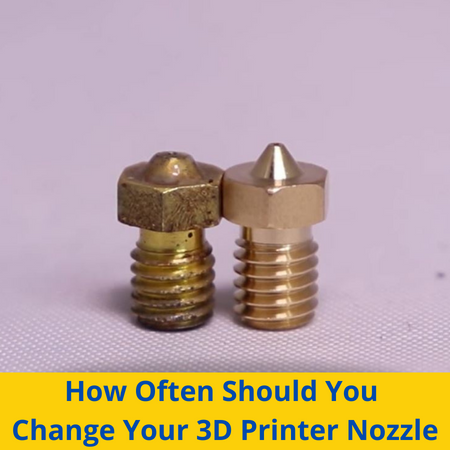
The nozzle is easily one of the most important parts of a 3D printer.
This small metal component is responsible for controlling the volume and shape of the outflowing melted filament. It’s also the last point on your machine that the molten plastic touches before being laid out on the build plate.
But nozzles, especially brass ones, don’t last forever. Over time and after extended use of your printer, nozzles degrade and wear, which negatively impacts the quality of your prints and causes all sorts of issues, from stringing to under-extrusion.
So when should you change your 3D printer nozzle?
Well, that depends. The lifetime of a nozzle depends on a handful of different factors, such as the material of the nozzle, what filament material you’re using, and how much you’re printing.
For a reference point, though, I’ll give you an example. If you’re using a standard brass nozzle on a Creality Ender 3 and print 100g of PLA filament every two weeks, then you can expect the nozzle to last roughly between 8-16 weeks. Of course, some nozzles will last longer and some will last less, but this range is generally true.
Want to learn more about the longevity of 3D printer nozzles, as well as how you can change them? Just keep reading!
Table of Contents
- How Often Should You Change Your 3D Printer Nozzle?
- Why Change the 3D Printer Nozzle?
- How Long Do 3D Printer Nozzles Last?
- How to Tell if Your Nozzle Needs to be Changed?
- How to Change the Nozzle on 3D Printers?
- Signs of a Worn Out Nozzle
- How to Make the Nozzle Last Longer?
- Best 3D Printer Nozzles
- Conclusion
How Often Should You Change Your 3D Printer Nozzle?
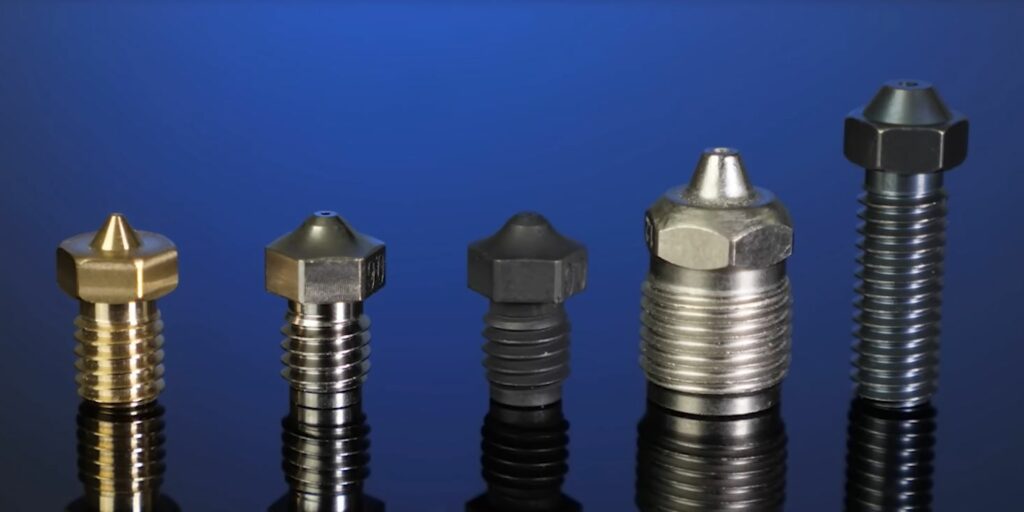
While it’s difficult to estimate the “lifetime” of a 3D printer nozzle, in general, most need to be replaced after about 2-4 months (8-16 weeks).
But this is just a general range and won’t be true for every person and their printer. That’s because so many different factors go into determining the actual longevity of each 3D printer nozzle, including the following:
- The material of the nozzle
- The brand and quality of the nozzle
- The filament material you’re using
- The brand and quality of the filament
- How much filament you’re printing
- The hot end configuration (is it set up correctly?)
Keep these elements in mind when determining when to change your nozzle. For example, if you’re using a low-end brass nozzle and are printing non-stop, then you can expect to change the nozzle more frequently than if you were using a high-end hardened steel nozzle.
And, if you notice that you’re having to replace the nozzle more frequently than every 2 months, then you should look into what might be causing this problem. It might be a fault in the hot end assembly (e.g. a loose screw), wet filament, or something else.
Perhaps the most common cause of over-frequent nozzle changes, though, is trying to print an abrasive material on a low-end nozzle. Moreover, abrasive filament materials, such as carbon fiber nylon, polycarbonate, and glow-in-the-dark PLA, will degrade brass nozzles at a rate exponentially faster than hardened steel or ruby nozzles.
Why Change the 3D Printer Nozzle?
Changing the nozzle on your 3D printer is necessary if you want to achieve successful, high-quality 3D prints.
Because 3D printer nozzles are not invincible, they degrade over time, especially when printing abrasive filaments. When a nozzle degrades and wears down, the flow of filament out of the nozzle is less consistent and more prone to issues like under-extrusion, blobs on prints, and stringing.
And if the nozzle is worn down so much that it’s completely clogged, filament will stop flowing entirely!
As such, it’s absolutely vital that you change your 3D printer nozzle when you start noticing the signs of degradation, like gaps in the layers of your prints or blobs and zits on the model’s outer surface.
How Long Do 3D Printer Nozzles Last?
As I mentioned, the typical longevity of a 3D printer nozzle depends on many factors. One of the most important ones, though, is the nozzle material.
There are a handful of options for the nozzle material, like brass and hardened steel, and each can last different amounts of time. I’ve gone over the average lifetime of each nozzle material in the sub-sections below:
Brass
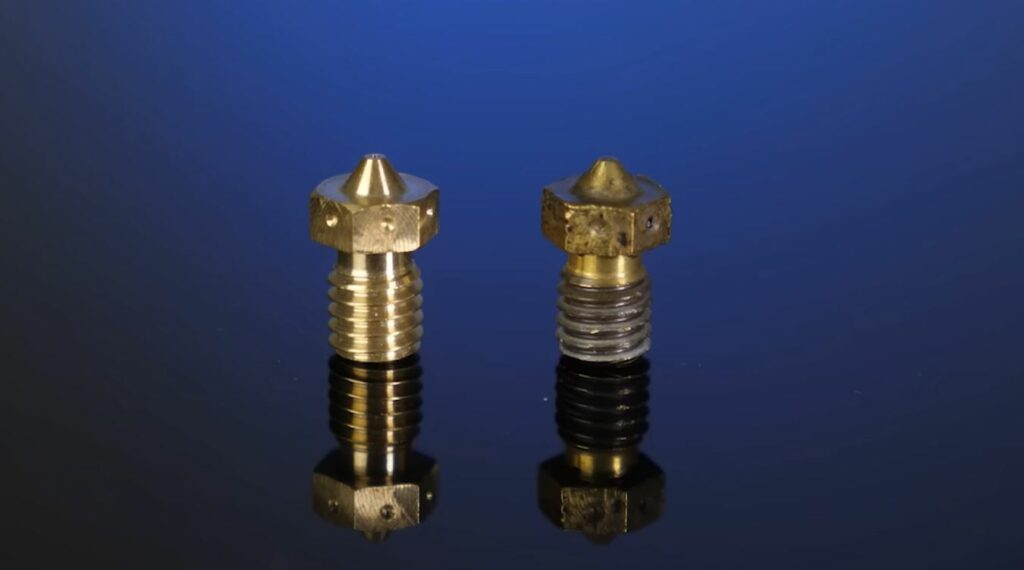
Brass is, by far, the least expensive nozzle material, and you can find brass nozzles on almost every budget 3D printer, like the Creality Ender 3 and Prusa i3 MK3S+. As you can expect, brass nozzles last the least amount of time out of the other nozzle material options because the metal material is inherently less abrasion-resistant than the others.
The typical lifetime of a brass nozzle ranges from 4-8 weeks if you’re printing at least once per week. Of course, some people, including myself on a few occasions, have had a brass nozzle last many months before failure. But 4-8 weeks is average.
Stainless Steel
Stainless steel is another nozzle material, mainly known for its anti-stick abilities. Furthermore, if you use a stainless steel nozzle, melted plastic goo isn’t likely to stick to the tip of the nozzle, which is why this type of nozzle is commonly used for printing food-safe models.
As for longevity, stainless steel nozzles fare a bit better than brass ones, but they are also more expensive. Most stainless steel nozzles can last 6-12 weeks, depending on the build quality of the nozzle.
Hardened Steel
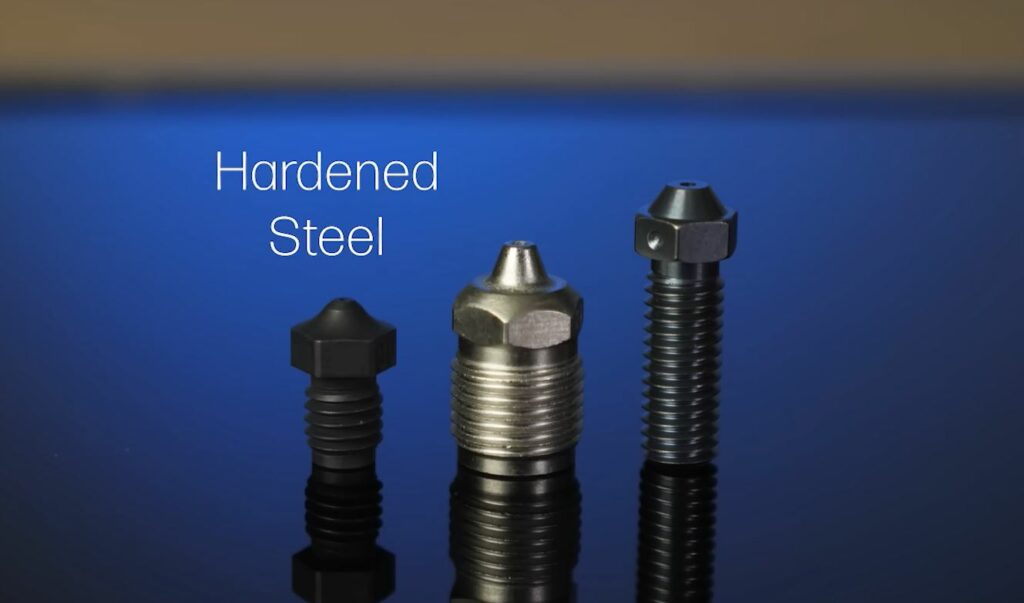
Next, hardened steel nozzles last much longer than brass or stainless steel options. Their typical lifetime runs between 15 and 30 weeks and even longer if you’re only printing regular PLA filament (as it’s non-abrasive).
But the 15-30 week lifespan of a hardened steel nozzle comes at a price well above that of a brass nozzle. But, if you’re interested in printing a wide range of filament materials, a hardened steel nozzle is a great option and will last a decently long time.
Check out our article about Brass vs Stainless Steel vs Hardened Steel Nozzle to learn more.
Ruby & Tungsten
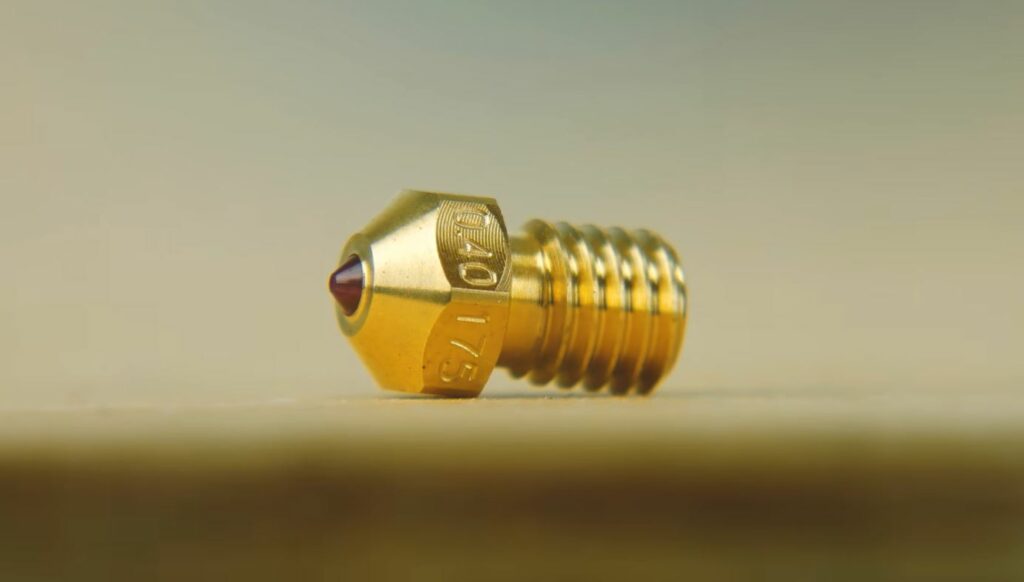
Lastly, ruby and tungsten are easily the most long-lasting nozzle materials. Nozzles made from ruby or tungsten are usually marketed as lasting forever.
“Just buy once, and you’ll never have to replace it!”
While this isn’t always true, ruby and tungsten nozzles certainly last longer than hardened steel nozzles. Their average lifespan ranges from 30-100 weeks! And, If you’re exclusively printing PLA or another non-abrasive filament material, lasting literally forever isn’t off the table.
Ruby and tungsten nozzles, though, cost a lot more than any of the other material options. For example, the Olsson Ruby nozzle, perhaps the most popular ruby nozzle option, costs around $100.
How to Tell if Your Nozzle Needs to be Changed?
You’ll know that your 3D printer nozzle needs to be replaced when you start noticing print quality defects that are related to extrusion.
Gaps in the layers (under-extrusion), blobs and zits on the outer surface of your print, stringing, and ghosting are all potential signs of a worn-out nozzle. And, obviously, if no filament at all is flowing out the nozzle at all, then it’s definitely time to replace the part.
And, if you’ve been printing on the same nozzle for a very long time (e.g. 25 weeks), that doesn’t mean it needs to be replaced. As the saying goes, “Don’t fix it unless it’s broken”.
However, one exception I have for this rule is if you’re printing a large model that will take a long time and want to ensure its success. It’s probably a better idea to replace your old nozzle before starting the long print than for it to fail in the last 10% of the print. Of course, this happening is unlikely, but, if you’re worried, it’s better to be safe than sorry.
How to Change the Nozzle on 3D Printers?
Changing the nozzle on 3D printers is super easy, and I’ve gone over the process in the steps below:
1. Heat Up Nozzle
The first step to changing your nozzle is heating it up so we can remove the filament. To do this, go on your printer’s LCD menu, click “Control”, and then set the nozzle temperature to the suggested value for whatever filament you have loaded.
2. Remove Filament
Next, we’ll need to remove the filament. With the nozzle heated up, pull the extruder tension lever with one hand, and, with the other, gently push the filament forward, before quickly pulling it back. Continue pulling the filament until it’s out of the printer’s PTFE tube and outside the extruder assembly.
Note that pushing the filament forward right before pulling it back will reduce the chances of a hot end clog.
3. Unscrew Nozzle
With the filament removed and the nozzle still hot, use the proper tool (e.g. wrench or special tool) to unscrew the nozzle from the bottom of the hot end assembly. The nozzle will likely be a little tight when you first start to unscrew it, but with a little force, it should start to unscrew easily.
If you’re having trouble unscrewing the nozzle and don’t want to risk breaking the hot end assembly, increasing the nozzle temperature can help loosen things up.
4. Clean Hot End
Before we screw the new nozzle back in, it’s important to clean the inside of the hot end assembly. This will ensure that, when the new nozzle goes in, no contaminants in the hot end will negatively impact the flow of filament.
To clean the hot end, first, make sure that it’s still heated up. Then, take some PTFE tubing (it could be your current PTFE tube or a spare tube) and push it through the hot end assembly and out the bottom. This should push any unwanted guck out.
With the end of the PTFE tube sticking out the bottom of the hot end, use a wipe to remove the guck. Then, pull the PTFE tube back out. For an even cleaner hot end assembly, you can pick any other substances out of the hot end with a small metal pick.
5. Screw New Nozzle In
Now, it’s time to screw the new nozzle onto your hot end! To do this, pick up your new nozzle with one hand and screw it into the bottom of the hot end assembly for one or two rotations. Try to be quick, so the nozzle doesn’t heat up and burn your fingers.
Once the nozzle is screwed in just a tad bit, take your nozzle tool and finish screwing it into the hot end assembly. It should be tightly on there, but you shouldn’t need to use too much force. Furthermore, try not to over-tighten the nozzle on the hot end as this could lead to something bending or breaking.
6. Load Filament
Finally, load the filament into your printer’s extruder. Then, pull the extruder tension handle and push the filament the rest of the way through the PTFE tube until you start to see melted filament coming out of the nozzle.
Signs of a Worn Out Nozzle
While I briefly mentioned a few signs of a worn-out, degraded nozzle, I want to take a deeper dive into these symptoms. I’ve gone over the most common ones below:
1. Gaps In Layers (Under-Extrusion)
Gaps in the layers of your print are perhaps the most common indicator that your nozzle is worn out or clogged. Furthermore, gaps in the layers of a print are one of the main signs of under-extrusion, which is when not enough filament is flowing out of the nozzle.
The frequency of gaps in the layers of prints will vary based on how degraded the nozzle is. But, it should look something like this:
2. Stringing
Stringing is another extrusion-related print quality issue and it’s another potential sign that your nozzle is worn out. Stringing is technically a form of over-extrusion and is when small string-like features appear on your print, usually between two distinct features on the model. If your nozzle is worn out or partially clogged, stringing will be more frequent on your prints.
3. Zits & Blobs
Another form of over-extrusion that might be caused by a worn-out nozzle is zits and blobs on the outer surface of your 3D print. These hurt the visual appearance of your model as well as its surface texture. If the nozzle has a deformed shape, which can happen over time, then blobs and zits will show up more on prints.
4. Poor First Layer Adhesion
Next, poor first-layer adhesion is another sign of a worn-out nozzle. This is when the first layer of your print isn’t sticking well to the build plate. While this can be caused by a handful of different factors, like wet filament or an unlevel bed, a degraded nozzle is also a potential cause.
You can check out our article about filament dryers to dry your wet filament.
5. Total Print Failure
Finally, a total print failure is always possible with a worn-out nozzle. This is when filament completely starts flowing out of the nozzle, likely due to a full clog inside the nozzle component. Obviously, this is the worst outcome of a degraded nozzle.
How to Make the Nozzle Last Longer?
If you don’t want to have to change your nozzle as frequently, there are a few things you can do to make your nozzle last longer. These methods will save you both time and money, and also make your overall printing experience better.
1. Use Non-Abrasive Filaments
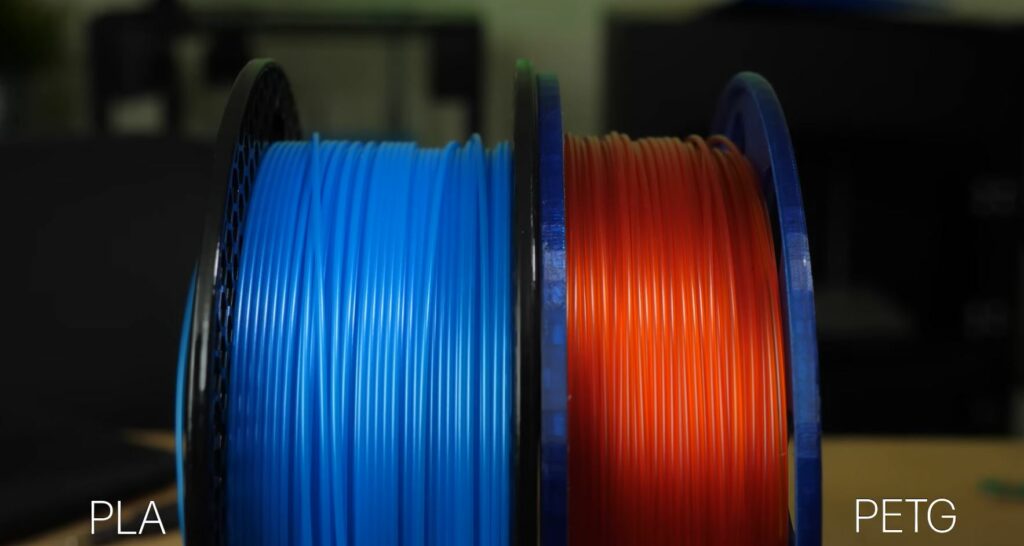
First, try to print with non-abrasive filament materials. Non-abrasive filaments, like PLA, PETG, ABS, and TPU, won’t degrade nozzles as fast as abrasive filaments, like composite PLA and polycarbonate.
2. Clean Nozzle Regularly
Cleaning the nozzle regularly also helps make the part last longer. I suggest removing the nozzle from your printer, cleaning the exit hole with a small needle, and also cleaning the hot end every month. Doing so only takes a few minutes and can make your nozzle last months longer.
3. Don’t Change Filament Frequently
Finally, don’t change your filament as frequently. Each time you change your filament, especially when switching from one filament material to another (e.g. PLA to ABS), the nozzle becomes more worn out. Sticking with the same filament will make your nozzle last longer.
Best 3D Printer Nozzles
If you’re interested in the best 3D printer nozzles, I’ve provided some of the best options in the bullet points below:
- E3D V6 Brass Nozzle
- E3D V6 Hardened Steel Nozzle
- MicroSwiss Hardened Steel Nozzle
- E3D Nozzle X
- Olsson Ruby Nozzle
Conclusion
Overall, 3D printer nozzles are extremely important to the 3D printing process, but they don’t last forever (or at least not most of them). Typically, you should replace the nozzle on your 3D printer every 8 to 16 weeks.
However, the true lifetime of a 3D printer nozzle depends on the material and quality of the nozzle, what filament you’re using, and how frequently you’re printing. As such, it’s impossible to give an exact estimate for the longevity of a nozzle.
But, if you want your nozzle to last the longest, you should use a more abrasion-resistant option, such as a hardened steel or ruby nozzle. Additionally, using non-abrasive filaments, like PLA and PETG, and regularly cleaning the nozzle also go a long way in extending the life of your nozzle.
Hope this helps!
Related Articles:


